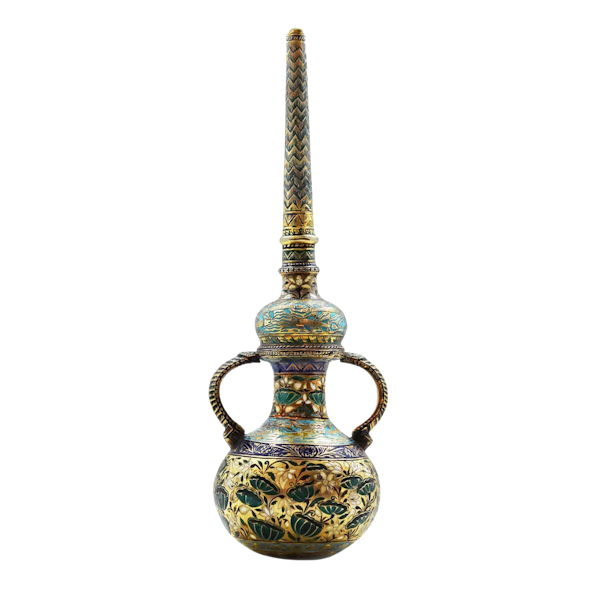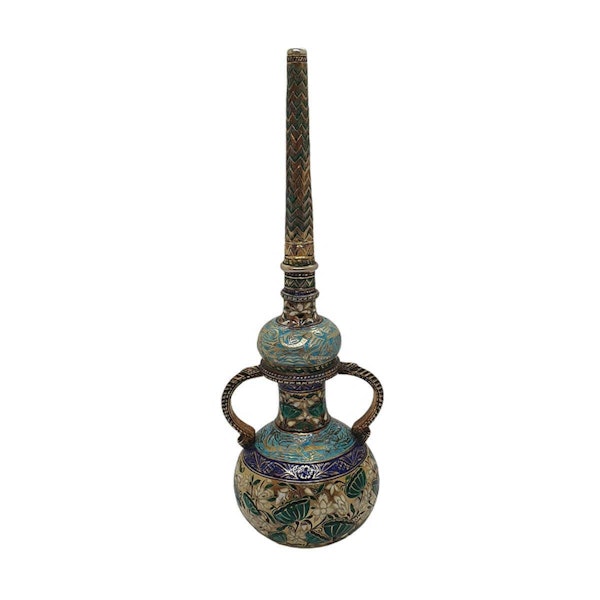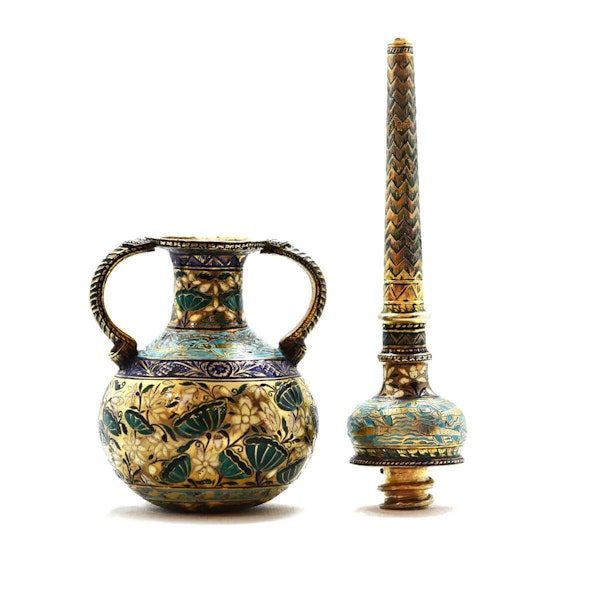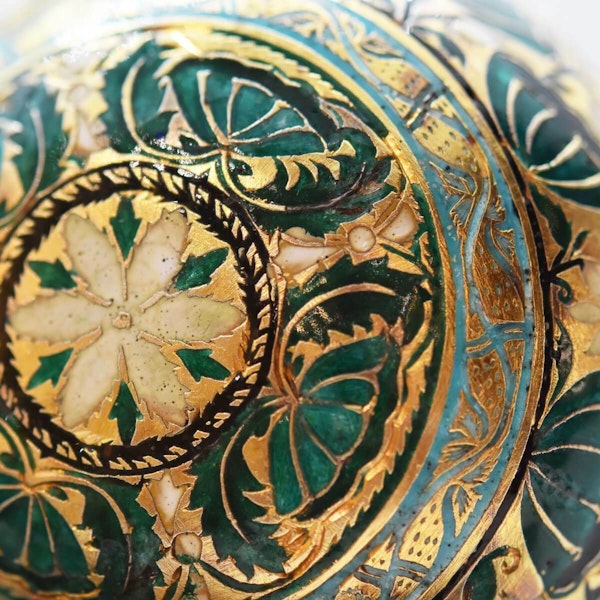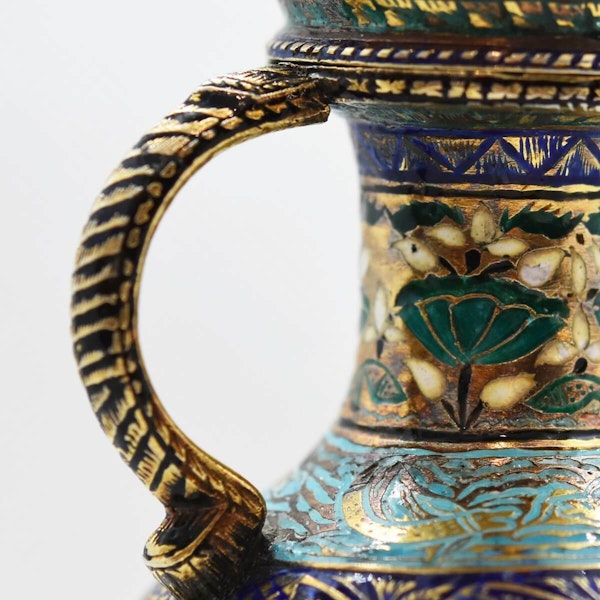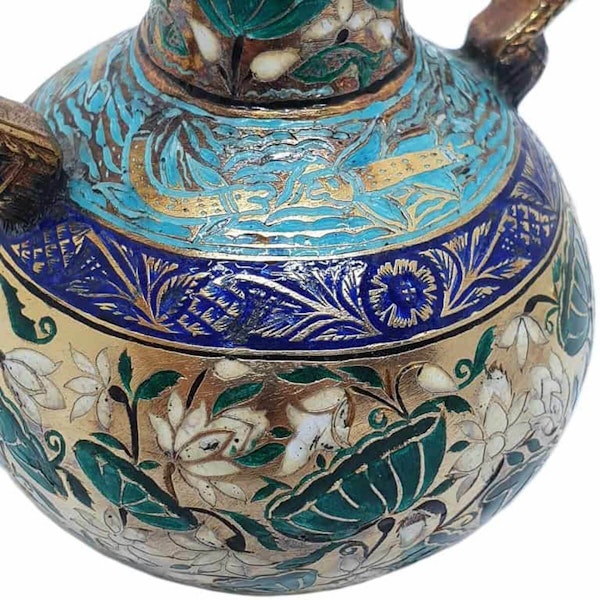Antique Indian Enamelled (Minakari) Oil Dispenser, India - 18th Century
Antique Indian Enamelled (Minakari) Oil Dispenser, India - 18th Century
£6,500.00
Description
This antique Indian enamelled oil dispenser was likely made for use within a large residential dwelling or temple complex, where many lamps needed filling and would have been used to hold the oil to fill the lamps. In India, oil lamps would have provided all supplementary light to the property once the sun had gone down. The vessel was designed to hold the oil safely and to pour the oil into the lamps without spilling any. This was important for three reasons; minimising fire hazard, minimising accidents caused by slippage on spilt oil and minimising costs. It is not known where this oil dispenser was made but probably Jaipur. Hendley states that there were thirteen principal enamelling centres and that in Jaipur, one of the most important centres, the lotus flower design was a traditional favourite.
The oil pourer has been ornamented with colourful enamels of dark blue, dark green, cream, black and turquoise. The neck can be unscrewed from the base at a point immediately above the handles. The neck has been ornamented with repeating zig-zag bands which contain green enamel. A similar pattern has been used to ornament the stem of an 18th century Indian turban ornament, or sarpech, within the David Collection. As some of the enamel to the neck has now been lost, the underlying structure of the hatched surface beneath is revealed. Hatching was a process used to help the enamel bond better to the surface of the metal. Travelling downwards, there are two protruding knops separated by a geometric band which create a place for the fingers to support the neck whilst guiding the upper end of the neck into the correct position before pouring. The lowest portion of the neck contains a border of creamy lotus blossoms with green leaves, portrayed in a naturalistic style. The bulge which follows has a turquoise enamel ground with golden fish, a naïve depiction of a river and an arrangement which places the lotus flowers above in context.
The lower part of the vessel has two handles ornamented with stacked, or repeating chevrons containing black enamel and recalling the zigzag border to the neck above. Within the David Collection is an 18th century enamelled lidded bowl where a similar chevron pattern has been used to ornament the foot and rims. Inlaid chevrons to the rims of bidri wares of the same period are found frequently. As before, lotuses follow with their creamy petals and green leaves. This time the depiction is more formal in style with the side views of the large upright lotus pods on their straight vertical stems interspersed by fish dominating. Following on, another depiction of a river with turquoise water and golden fish with a stylised floral and foliate border of dark blue enamel beneath. Within the David Collection is an 18th century enamelled hookah base from Lucknow which portrays a river in a similar way and using similar colour. The principal border is deep and encircles the widest part of the body of the dispenser. It is a study of the lotus with flowers once again dwarfed by the larger lotus pods which are portrayed in a more relaxed and more naturalistic arrangement here. A narrow ‘fish and river’, border below leads down to the rounded underside of the base.
To the centre of the underside is a fully open lotus flower, with a green leaf nestling between adjacent petals, depicted as if viewed from above. This medallion framed by a simple geometric border of black enamel and, in turn, surrounded by a repeating lotus pod border in formal style. Each pod or seed head is flanked by a large leaf at either side with the pods separated by a slender, drop shaped arrangement of creamy lotus petals.
The near spherical body to the base of the dispenser forms the reservoir which holds the oil, ensuring that the maximum weight lies nearest the base. The underside of the base itself is rounded not flat and should something knock into the vessel when it had been placed on a table or shelf, this effective design would work together with gravity so that it rocked and wobbled on its base rather than toppling straight over and spilling the oil. There are strong similarities of design with the ubiquitous toddlers’ ‘spillproof’ training cups in common use today which, have a similar shaped base and two handles, placed one at either side.
A smaller, near spherical reservoir which feeds the oil to the long neck, can be seen above the handles, Grasping both handles, the dispenser could be quickly inverted above the lamp and held in the vertical position until the lamp was full when the vessel would be reversed with another quick movement. The secondary reservoir and very long neck have the effect of delaying the emergence of the oil by milliseconds, again helping to avoid unnecessary spillage. The oil would be dispensed via the single small hole at the top of the neck. The top part of the vessel unscrews from the base to accommodate filling and cleaning, as can be seen in the photos.
The art of enamelling is believed to have been brought to India from Persia and most enamellers or minakars were members of the Sikh religion in the Punjab who worked in their own homes, assisted by members of their family. They did not deal with the public directly but worked as sub-contractors to the trade. A metal worker would form the object and his chaser would chase the surface of the object with the chosen design, hollowing out depressions to accept the enamel and hatching them to facilitate the bonding of the two materials; a lengthy and painstaking process. It would then be passed to the minakar to enamel. This type of enamelling is usually referred to as baisse-taille enamel.
Usually, the enamellers did not manufacture the vitreous materials they used for enamelling themselves but bought it in and then ground it down and mixed the colours in their workshop. The enamelling process was lengthy and very complex, requiring many different stages of cleaning with acid, firing and burnishing. Objects were fired in clay ovens and were placed on pieces of talc during firing. Different colours of enamel required different firing temperatures, necessitating a strict order of application. If one firing was not successful, it would be redone until it was perfect. Reportedly, some elaborate pieces required as many as eighteen separate firings with cleaning and polishing between each firing.
| item details | |
|---|---|
| Origin | Asian |
| Period | 18th Century |
| Style | Other |
| Condition | Excellent |
| Dimensions | Weight: 288 grammes |
| Diameter | Height 21.5cms; Width 7.5cms |
Product REF: 10047
